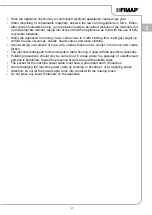
To clean the detergent solution spray nozzle proceed as follows:
1.
Take the device to the dedicated maintenance area.
ATTENTION
: the place designated for this operation must comply with current environmental
protection regulations.
2.
Check that the plug (1) on the power cable (2) has been taken out of the socket (3) of the mains
supply(
Fig.1
), and if not, disconnect it.
ATTENTION:
these operations must be carried out using protective gloves to avoid any possible
contact with the edges or tips of metal objects.
ATTENTION
: To prevent damaging the power cable, disconnect the plug from the mains socket
by directly pulling the plug and not the cable.
3.
Make sure the solution tank is empty, otherwise empty it completely.
4.
Remove the ring nut fixing the nozzle (4) (
Fig.2
).
5.
Remove the spray nozzle (5), being careful not to lose the washer (6) (
Fig.3
).
ATTENTION
: users are advised to always wear protective gloves, to avoid the risk of serious
injury to hands.
6.
Clean the nozzle under a jet of running water, if necessary remove any impurities.
7.
Repeat the operations in reverse order to reassemble all the parts.
19.4. CHECKING AND CLEANING THE SOLUTION SPRAYER NOZZLE
21. TROUBLESHOOTING
This chapter lists the most common problems linked with the use of the appliance. If you are unable to
resolve the problems with the information given here, please contact your nearest assistance centre.
The undersigned manufacturer:
FIMAP S.p.A.
Via Invalidi del Lavoro, 1
37059 Santa Maria di Zevio (VR)
declares under its sole responsibility that the products
SINGLE DISC MACHINES
mod. FM43 ORBITAL EXTRA SPRAY
comply with the requirements of the following Directives:
•
2006/42/EC: Machinery Directive.
•
2014/35/EC: Low Voltage Directive.
• 2014/30/EC: Electromagnetic compatibility directive.
They also comply with the following standards:
•
EN 60335-1: Household and similar electrical appliances - Safety. Part 1: Generic standards.
•
EN 60335-2-67: Household and similar electrical appliances. Part 2: Specific standards for
automatic machines for floor treatment for commercial and industrial use.
•
EN 12100-1: Safety of Machinery - Basic concepts, general principles for design - Part 1: Basic
terminology and methodology.
•
EN 12100-2: Safety of Machinery - Basic concepts, general principles for design - Part 2: Technical
principles.
•
EN 55014-1: Electromagnetic compatibility - Regulations for household appliances, electrical
devices and similar equipment. Part 1: Emission - Regulation for product family.
•
EN 55014-2: Electromagnetic compatibility - Regulations for household appliances, electrical
devices and similar equipment. Part 2: Immunity - Regulation for product family.
•
EN 61000-3-2: Electromagnetic compatibility (EMC) - Part 3-2: Limits – Limits for harmonic current
emissions (Equipment with input current ≤ 16A per phase).
• EN 61000-3-3: Electromagnetic compatibility (EMC) - Part 3-3: Limits – Limitation of voltage
fluctuations and flicker in low voltage power supply systems for equipment with rated current ≤ 16A.
•
EN 62233: Household and similar electrical appliances - Electromagnetic fields - Methods for
evaluation and measurement.
The person authorized to compile the technical file:
Mr. Giancarlo Ruffo
Via Invalidi del Lavoro, 1
37059 Santa Maria di Zevio (VR)
Santa Maria di Zevio (VR) Italy, 27/09/2016
TMB S.r.l.
Legal representative
Giancarlo Ruffo
20. EC DECLARATION OF CONFORMITY
22
EN
1
2
3
1
4
6
5
2
3
22. DISPOSAL
To dispose of the appliance, take it to a demolition centre or an
authorised collection centre.
Before scrapping the appliance, it is necessary to remove and
separate out the following materials, then send them to the
appropriate collection centres in accordance with applicable
environmental hygiene regulations:
•
Pad holders or brushes
•
Electric and electronic parts*
• Plastic parts
• Metallic parts
(*) In particular, contact your distributor when scrapping electric
and electronic parts.
PROBLEM
POSSIBLE CAUSE
SOLUTION
THE APPLIANCE
DOES NOT
SWITCH ON
The power cable extension is not
connected to the mains socket.
Check that the plug on the extension
cable has been inserted into the
mains supply socket.
The power cable extension is not
connected to the appliance's power
cable.
Check that the plug on the cable of
the appliance has been inserted into
the socket on the extension cable.
The electrical specifications of the
appliance should correspond to the
electrical specifications of the power
supply network.
Make sure that the electrical
specifications of the appliance
correspond
to
the
electrical
specifications of the power supply
network, check the technical
information on the serial number
plate.
Extension cable damaged.
Check the extension cable is not
damaged, and if it is, replace it.
Overheating of the brush head
motor.
Make sure that the thermal breaker
on the back of the handlebar has not
tripped. If it has, wait a few minutes
until it has cooled down, then press
the specific circuit breaker button
to reactivate the power supply and
motor operation
INSUFFICIENT
DETERGENT
SOLUTION ON
THE PAD HOLDER
The amount of detergent in the
solution tank is insufficient for the
work that needs doing.
Make sure that the amount of
detergent solution in the solution
tank is sufficient for the work to be
carried out, and if necessary fill the
solution tank.
















































